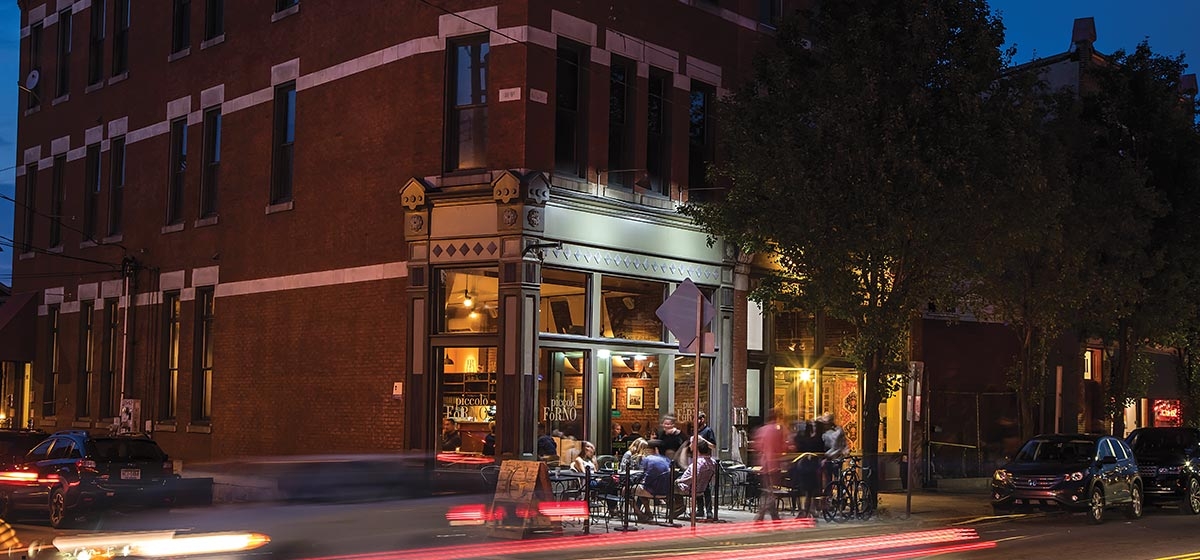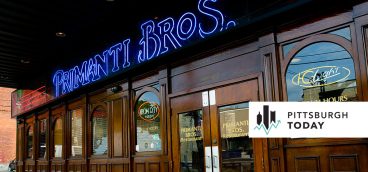
In 1968, Pittsburgh Chef Ferdinand Metz cabled from Frankfurt, Germany, to tell his friends that the U.S. Team won the Grand Gold Award in the International Culinary Competition. He was at the top of the culinary world, with 16 gold medals and the grand award given to him and his team. And thousands came when Metz taught culinary classes at H.J. Heinz, where he led research and development.
[ngg src=”galleries” ids=”127″ display=”basic_thumbnail” thumbnail_crop=”0″]
The expertise of Metz and other local chefs belies the notion that, until recently, Pittsburgh was something of a culinary desert. What has changed dramatically, however, is the scale and number of highly regarded restaurants, along with the diversity of menu options. While in the 1980s there were six or seven world-class dining spots, today dozens of restaurants and chefs are receiving national acclaim for different styles of cooking. The New York Times and Washington Post recently featured Pittsburgh’s thriving restaurant industry. Bon Appetit called Pittsburgh the next Great Food City in 2014. And last year, Zagat ranked Pittsburgh as America’s No. 1 food city.
But with success has come problems that would have been inconceivable two decades ago. Staffing has become a major challenge. And many restaurant entrepreneurs believe that, despite its many recent accolades, the local industry is experiencing a bubble that’s destined to burst, with too few qualified workers and too many new restaurants for the customer base. In short, they fear that something’s got to give.
Tracing the climb of Pittsburgh’s cuisine
One of Metz’s favorite places to dine was La Normande. Its chef was Tim Ryan, a 21-year-old prodigy who pushed boundaries in the late 1970s and changed his menu daily. Toni Pais, who went on to become one of the most important chefs in Pittsburgh, watched Ryan in awe when he worked at La Normande.
“He was like a painter,” Pais says. “He didn’t have to be taught. He just knew. He went to France and would come back with ideas that were unbelievable.”
Ryan began his career as a busboy at Nino’s when he was 13. The owner, Nino Sorci, a well-respected Pittsburgh chef, mentored him. Ryan also devoured cookbooks at Carnegie Library. Eventually, he enrolled at the Culinary Institute of America. Ryan returned to Pittsburgh, working at Ben Gross’s before moving to La Normande.
“We had big dreams and big aspirations,” Ryan says. “As good as the other places were, that’s not what they were trying to do.”
Metz ultimately left Heinz in 1980 to become president of the Culinary Institute of America in New York. He recruited Ryan a few years later to join him. The pair would help shape national cooking trends for more than three decades. Though Pittsburgh lost two of its greatest talents, their understudies would continue to push the boundaries in local kitchens.
In the 1980s, La Normande was considered Pittsburgh’s greatest restaurant, continuing its excellence when Cathy Armburger took the helm following Ryan’s departure. But many other restaurants had long received praise.
Hyeholde Restaurant, which opened in Moon in 1939, showcased French cuisine. The Park Schenley was a hit for decades, reaching its peak in the 1950s when colorful, European-trained head chef Dino Nardi manned the kitchen and served diners (including Eleanor Roosevelt) his Broiled Club Steak Florentine and Stuffed Deviled Crab. Both the Wooden Angel in Beaver, which opened in 1968, and the Carlton, which opened in 1984, pioneered accessible and affordable wine lists to accompany their classic fare. And LeMont on Mount Washington has been the temple of traditional Italian food for 60 years.
The city remained a place of culinary excellence even after La Normande closed in 1989. Michael and Candace Uricchio opened the critically acclaimed Laforet in 1988.
“It is not a restaurant for beginners,” wrote the Post-Gazette’s Mike Kalina, the city’s preeminent dining critic at the time. “Only a young chef, like Uricchio, (he’s under 30), would be brash and daring enough to include dishes on a limited menu that many diners may neither understand nor appreciate.”
Uricchio and pastry chef Candace both trained in Europe and brought many techniques back. But they also brought with them European cooking equipment that was hard to get in America, enabling them to be more creative. “People noticed a difference,” says Michael Uricchio. “We never tried to disguise things. If we got the best lamb in the country, we wouldn’t smother it with sauces. We kept things simple. It was an event to dine there. You could spend hours eating at Laforet.”
They were part of a second wave of great chefs that included Pais, Andrea Schrenk, now Giant Eagle’s executive pastry chef, and Keith Coughenour of the Duquesne Club.
The Duquesne Club is one of the city’s longest running institutions, dating back to the late 19th century. Among the chefs in its history was Abel Bomberault, who held court there from 1932 to 1962 and introduced the city to shepherd’s pie, vichyssoise and Virginia spots. He emphasized fresh ingredients and plenty of seafood, a tradition Coughenour has continued since becoming the club’s executive chef in 1992.
Coughenour was team USA captain in 1992 and 1996 in the Culinary Olympics. He was the American Culinary Federation’s best chef in the Northeast in 2003. And at one point, he was in the running to be White House chef. And the people he mentored—Greg Alauzen, Derek Stevens, Rich Rosendale, Janice Palla, Kevin Sousa and Mike Caudill—have gone on to accomplish great things locally. Coughenour believes many of today’s chefs would benefit from an understanding and appreciation of their Pittsburgh predecessors.
“I think we should all know the historical achievements of past chefs who’ve been here,” Coughenour says. “Because they set the standards from which we evolved.”
The importance of mentors
Though the city had some excellent restaurants, it needed a catalyst to grow into the scene it is today—with top-notch dining spots in virtually every neighborhood. That spark came when two restaurants opened in 1993. One was Tom Baron’s Mad Mex, part of his larger restaurant group Big Burrito. The other was Pais’s Baum Vivant, featuring Mediterranean food.
“It wasn’t the most sophisticated dining scene,” Baron says of Pittsburgh when he arrived. “We seemed to be lacking in the concepts that had been in bigger cities. There didn’t seem to be a good amount of places that combined a happening bar with a good food experience.”
Baum Vivant was named best restaurant by local publications for more than a decade. And praise was heaped on Pais, who now owns Café Zihno, for his innovative dishes. He fused a variety of ethnic styles, including Chinese, African, Indian and Portuguese. It was also a classroom for aspiring chefs, many of whom would go on to work in other kitchens or open their own restaurants.
Big Burrito brought in Bill Fuller, a DuBois native who had worked in Washington, D.C., for seven years. When Fuller came to Pittsburgh in the mid-1990s to be closer to home, he was miserable during the long, cold winter. Though there were six or seven good restaurants, Fuller wasn’t impressed with the general dining climate in Pittsburgh.
“There wasn’t a scene with this culture of chefs who viewed it as a desirable profession,” he says. “There wasn’t much here at all. There were a lot of country clubs. It was pretty depressing.”
Slowly, however, as the city began to recover from steel’s collapse, the technology and medical sectors were attracting newcomers who brought tastes cultivated in other cities—and a push for better food in Pittsburgh. As Fuller notes, “They wanted more out of the market that was already here.”
“There wasn’t much here at all. There were a lot of country clubs. It was pretty depressing.”
—Bill Fuller
Baron and Fuller would go on to develop one of the most important partnerships in the city in the ensuing two decades. They focused on weaving together all aspects of eating out—the vibe, the food, the look and the crowd. They opened Kaya, Soba, Casbah and Eleven—all popular spots.
Other chefs began to make waves too, including Gloria Fortunato at Cafe Allegro and Sam DiBattista, chef and owner at Vivo. And Fuller mentored a group of chefs that included Sousa and Justin Severino.
Sousa had lived in other parts of the country before and after he graduated from culinary school in Pittsburgh in 1998. When he returned in 2000, he did a stint at the Duquesne Club before joining Soba in 2002 as a line cook.
“By the time I got to Bill, I already had my own cooking style,” Sousa says. “But what Bill and Big Burrito gave me was structure and knowing the elements of running a business.”
Sousa is best known for opening Salt of the Earth in East Liberty in 2010. He also opened a number of other restaurants including Union Pig and Chicken and introduced the city to his alchemy menu, a 25- course progressive dining experience, at the Bigelow Grille.
Severino, who had worked under Fuller at Casbah, developed his cooking style in Monterey, California, and wanted to open a restaurant in Santa Cruz. He was dissuaded, however, by the costs and in 2007 returned to Pittsburgh where he chose Lawrenceville to open Cure, which has garnered multiple James Beard nominations, as well as his newest venture, Morcilla.
“I think we opened up a part of town where nothing was going on,” Severino says. “No one knew who I was and we didn’t advertise. I think what the people said when they drove by was, ‘What the hell is that?’ No one had preconceived notions. I just started cooking the food I wanted to for people.”
Neighborhood by neighborhood
Lawrenceville is now filled with restaurants, but different chefs and entrepreneurs have created destinations in different neighborhoods.
Downtown’s development has accelerated since Sonoma Grille’s opening in 2004. Matthew Porco opened Sienna Mercato, a popular spot for young professionals near Sonoma and Seviche, and now that part of Penn Avenue bustles at night.
“We all deserve some credit,” says Yves Carreau, owner of Sonoma Grille, Seviche, NOLA and Poros on Market Square. “[Sonoma] got the ball rolling on that side of town. Market Square came later. It was the most beautiful area in the city.”
Rick DeShantz, owner of Meat & Potatoes and Butcher & the Rye, both Downtown, says part of his success is due to embracing the casual dining trend instead of taking a more buttoned-up approach. He designed his restaurants with that in mind.
“A restaurant is a whole experience. [With both restaurants] I tried to do the same thing. Drink-driven, unpretentious and low prices. And a balance of food from fun to things people can relate to.”
Others have followed that trend, including Brian Pekarcik, who with Rick Stern owns Grit & Grace, BRGR and Spoon. Trevett Hooper, owner of Legume and Butterjoint, also prefers a casual atmosphere in his Oakland restaurants. But there are still a number of elevated dining places such as Nine on Nine, Cioppino Restaurant, The Twisted Frenchman and Mount Washington’s Altius.
Then there’s the craze for hip hotel dining, with Habitat at the Fairmont, The Commoner at Hotel Monaco, Braddock’s at the Renaissance and the Whitfield at the Ace Hotel.
Too much of a good thing?
The thriving dining scene worries some who fear it has become oversaturated. And the 2012 closure of Le Cordon Bleu Institute of Culinary Arts, the only culinary school in the city, has created a different concern.
“We don’t have any sort of professional school that is feeding the system anymore,” says BRGR’s Pekarcik. “It’s always been a problem, but in the past seven or eight years, I think talented help is at an all-time low.”
Derek Stevens, the former executive chef at Eleven and now owner of the new Union Standard restaurant Downtown, agrees. “How many more [restaurants] can the workforce in Pittsburgh sustain? That’s what I wake up in the middle of the night worrying about—whether I’ll have a restaurant and have no one apply.”
Those concerns are widespread, but the new restaurants keep coming. Earlier this year, DeShantz opened Pork & Beans with chef Keith Fuller. It’s DeShantz’s fourth restaurant and Fuller’s second.
Having multiple restaurants augments the bottom line, according to Legume’s and Butterjoint’s Hooper, who will open a third soon. “You can’t own one restaurant and make the kind of living you made 20 or 30 years ago. That’s why the market is shifting. I’m not saying there aren’t restaurants that are profitable. I guess I’m thinking of the working chef who just worked and cooked in one restaurant. I think that would be hard nowadays because it would be hard to cook full time.”
“You can’t own one restaurant and make the kind of living you made 20 or 30 years ago. That’s why the market is shifting.”
—Trevett Hooper
Ultimately, the Pittsburgh restaurant boom may eventually lead to a restaurant recession, says Matt McClelland, executive chef with Cioppino Restaurant Group. “I think this is going to lead to a drastic decrease in restaurants in the city, because the competition is just going to keep driving each other under.”
It remains to be seen where the apparent Catch-22 will lead in a culture that, as Baron says, “has become so food oriented.”
Chefs have become local celebrities, appearing regularly in the Pittsburgh news media. Developers want them to anchor new real estate projects. And they’re even credited with the ability to transform neighborhoods.
The local palate also has matured, as have diner’s expectations. They go out now for the experience as much as the food. But with so much choice has come churn, and many older, established restaurants are struggling to stay open as even their regulars come less frequently.
Whatever happens, it’s unlikely that Pittsburgh food culture will revert to fried zucchini and wing joints—though there is still plenty of that out there, and probably always will be.




